Comprehensive Brand Management Report: Microsoft Case Study
VerifiedAdded on 2020/07/22
|17
|5876
|56
Report
AI Summary
This report provides a comprehensive analysis of brand management, using Microsoft Corporation as a case study. It begins by exploring the importance of branding as a marketing tool and its evolution in business practices. The report then delves into the key components of a successful brand strategy, focusing on building and managing brand equity. It examines various strategies for portfolio management, brand hierarchy, and brand equity management. Furthermore, it investigates collaborative brand management approaches at both domestic and international levels. The report also explores different techniques for measuring and managing brand value, supported by specific examples. The analysis covers brand identity, awareness, price premiums, and brand loyalty, along with strategies for brand revitalization and reinforcement. The report concludes by discussing the challenges of developing a brand, including emerging market performance and perceived quality, offering valuable insights into effective brand management practices. The report covers brand identity, awareness, price premiums, and brand loyalty, along with strategies for brand revitalization and reinforcement.

Brand Management
Paraphrase This Document
Need a fresh take? Get an instant paraphrase of this document with our AI Paraphraser
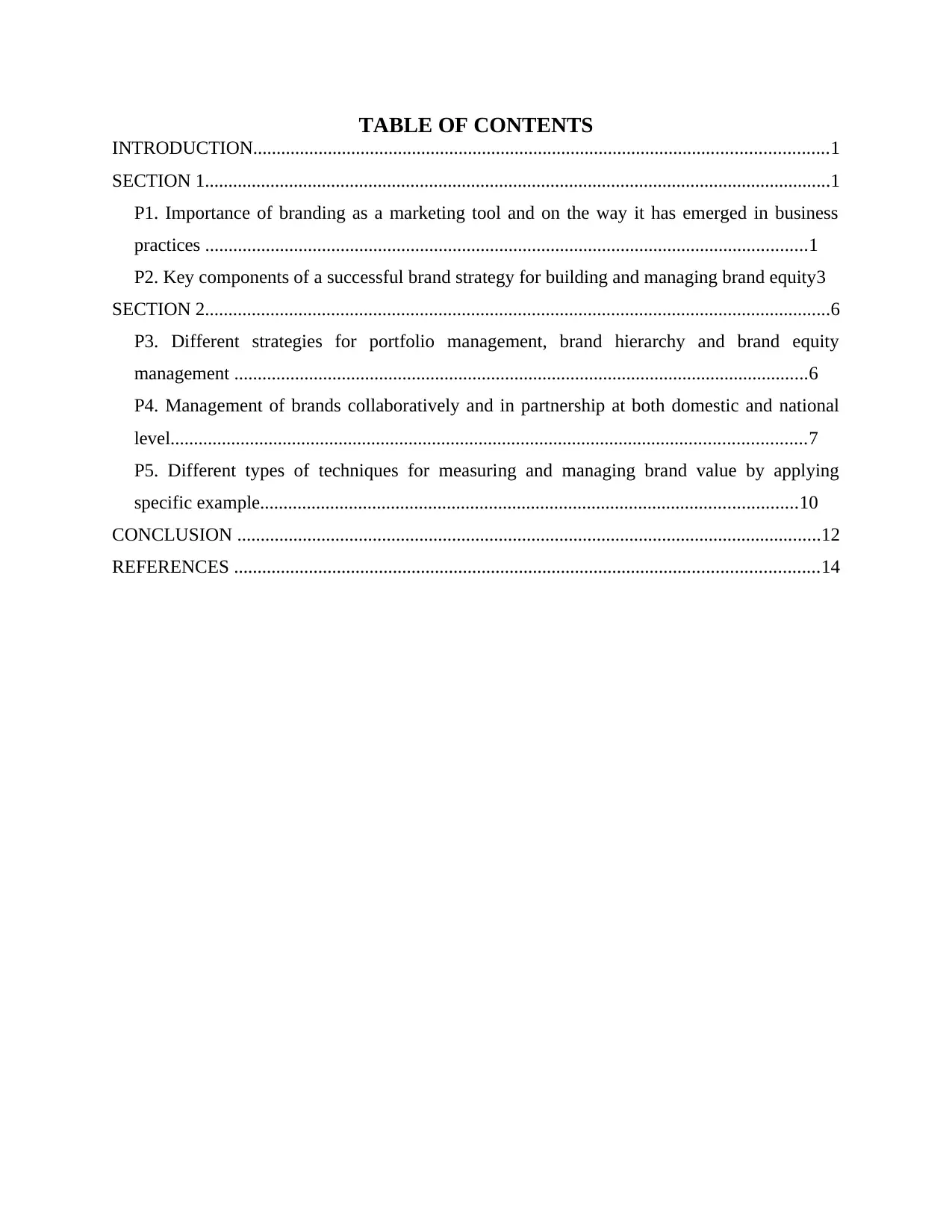
TABLE OF CONTENTS
INTRODUCTION...........................................................................................................................1
SECTION 1......................................................................................................................................1
P1. Importance of branding as a marketing tool and on the way it has emerged in business
practices .................................................................................................................................1
P2. Key components of a successful brand strategy for building and managing brand equity3
SECTION 2......................................................................................................................................6
P3. Different strategies for portfolio management, brand hierarchy and brand equity
management ...........................................................................................................................6
P4. Management of brands collaboratively and in partnership at both domestic and national
level........................................................................................................................................7
P5. Different types of techniques for measuring and managing brand value by applying
specific example...................................................................................................................10
CONCLUSION .............................................................................................................................12
REFERENCES .............................................................................................................................14
INTRODUCTION...........................................................................................................................1
SECTION 1......................................................................................................................................1
P1. Importance of branding as a marketing tool and on the way it has emerged in business
practices .................................................................................................................................1
P2. Key components of a successful brand strategy for building and managing brand equity3
SECTION 2......................................................................................................................................6
P3. Different strategies for portfolio management, brand hierarchy and brand equity
management ...........................................................................................................................6
P4. Management of brands collaboratively and in partnership at both domestic and national
level........................................................................................................................................7
P5. Different types of techniques for measuring and managing brand value by applying
specific example...................................................................................................................10
CONCLUSION .............................................................................................................................12
REFERENCES .............................................................................................................................14
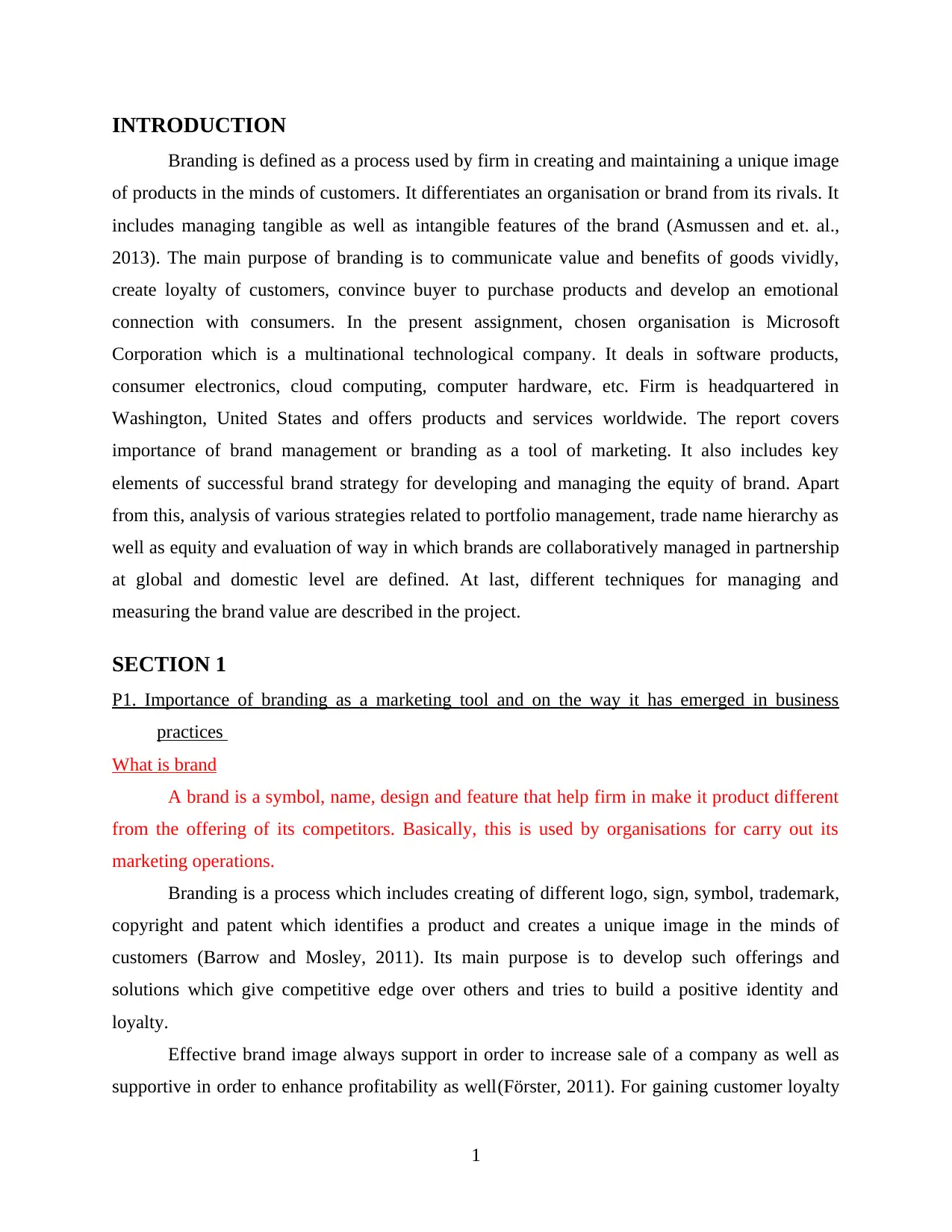
INTRODUCTION
Branding is defined as a process used by firm in creating and maintaining a unique image
of products in the minds of customers. It differentiates an organisation or brand from its rivals. It
includes managing tangible as well as intangible features of the brand (Asmussen and et. al.,
2013). The main purpose of branding is to communicate value and benefits of goods vividly,
create loyalty of customers, convince buyer to purchase products and develop an emotional
connection with consumers. In the present assignment, chosen organisation is Microsoft
Corporation which is a multinational technological company. It deals in software products,
consumer electronics, cloud computing, computer hardware, etc. Firm is headquartered in
Washington, United States and offers products and services worldwide. The report covers
importance of brand management or branding as a tool of marketing. It also includes key
elements of successful brand strategy for developing and managing the equity of brand. Apart
from this, analysis of various strategies related to portfolio management, trade name hierarchy as
well as equity and evaluation of way in which brands are collaboratively managed in partnership
at global and domestic level are defined. At last, different techniques for managing and
measuring the brand value are described in the project.
SECTION 1
P1. Importance of branding as a marketing tool and on the way it has emerged in business
practices
What is brand
A brand is a symbol, name, design and feature that help firm in make it product different
from the offering of its competitors. Basically, this is used by organisations for carry out its
marketing operations.
Branding is a process which includes creating of different logo, sign, symbol, trademark,
copyright and patent which identifies a product and creates a unique image in the minds of
customers (Barrow and Mosley, 2011). Its main purpose is to develop such offerings and
solutions which give competitive edge over others and tries to build a positive identity and
loyalty.
Effective brand image always support in order to increase sale of a company as well as
supportive in order to enhance profitability as well(Förster, 2011). For gaining customer loyalty
1
Branding is defined as a process used by firm in creating and maintaining a unique image
of products in the minds of customers. It differentiates an organisation or brand from its rivals. It
includes managing tangible as well as intangible features of the brand (Asmussen and et. al.,
2013). The main purpose of branding is to communicate value and benefits of goods vividly,
create loyalty of customers, convince buyer to purchase products and develop an emotional
connection with consumers. In the present assignment, chosen organisation is Microsoft
Corporation which is a multinational technological company. It deals in software products,
consumer electronics, cloud computing, computer hardware, etc. Firm is headquartered in
Washington, United States and offers products and services worldwide. The report covers
importance of brand management or branding as a tool of marketing. It also includes key
elements of successful brand strategy for developing and managing the equity of brand. Apart
from this, analysis of various strategies related to portfolio management, trade name hierarchy as
well as equity and evaluation of way in which brands are collaboratively managed in partnership
at global and domestic level are defined. At last, different techniques for managing and
measuring the brand value are described in the project.
SECTION 1
P1. Importance of branding as a marketing tool and on the way it has emerged in business
practices
What is brand
A brand is a symbol, name, design and feature that help firm in make it product different
from the offering of its competitors. Basically, this is used by organisations for carry out its
marketing operations.
Branding is a process which includes creating of different logo, sign, symbol, trademark,
copyright and patent which identifies a product and creates a unique image in the minds of
customers (Barrow and Mosley, 2011). Its main purpose is to develop such offerings and
solutions which give competitive edge over others and tries to build a positive identity and
loyalty.
Effective brand image always support in order to increase sale of a company as well as
supportive in order to enhance profitability as well(Förster, 2011). For gaining customer loyalty
1
⊘ This is a preview!⊘
Do you want full access?
Subscribe today to unlock all pages.

Trusted by 1+ million students worldwide
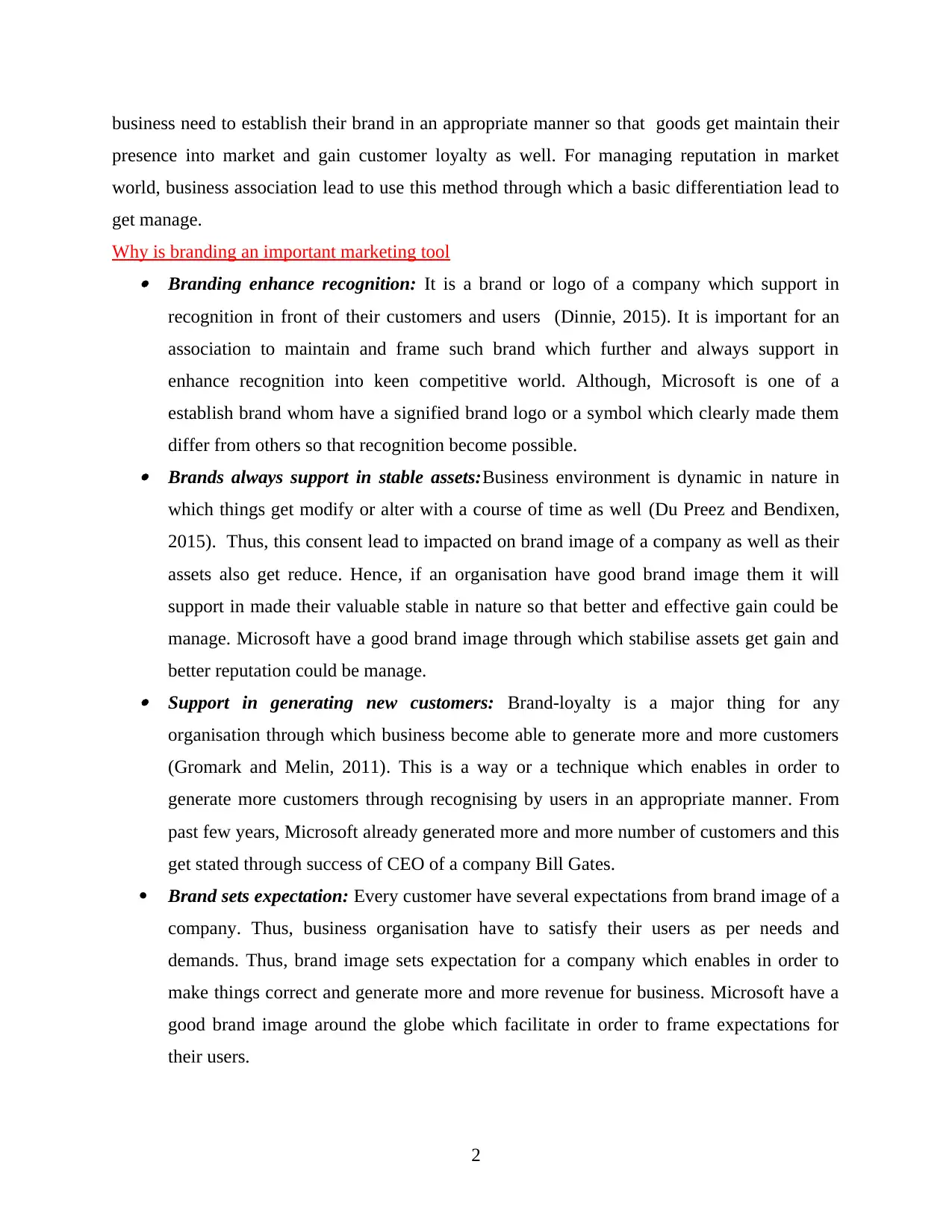
business need to establish their brand in an appropriate manner so that goods get maintain their
presence into market and gain customer loyalty as well. For managing reputation in market
world, business association lead to use this method through which a basic differentiation lead to
get manage.
Why is branding an important marketing tool Branding enhance recognition: It is a brand or logo of a company which support in
recognition in front of their customers and users (Dinnie, 2015). It is important for an
association to maintain and frame such brand which further and always support in
enhance recognition into keen competitive world. Although, Microsoft is one of a
establish brand whom have a signified brand logo or a symbol which clearly made them
differ from others so that recognition become possible. Brands always support in stable assets:Business environment is dynamic in nature in
which things get modify or alter with a course of time as well (Du Preez and Bendixen,
2015). Thus, this consent lead to impacted on brand image of a company as well as their
assets also get reduce. Hence, if an organisation have good brand image them it will
support in made their valuable stable in nature so that better and effective gain could be
manage. Microsoft have a good brand image through which stabilise assets get gain and
better reputation could be manage. Support in generating new customers: Brand-loyalty is a major thing for any
organisation through which business become able to generate more and more customers
(Gromark and Melin, 2011). This is a way or a technique which enables in order to
generate more customers through recognising by users in an appropriate manner. From
past few years, Microsoft already generated more and more number of customers and this
get stated through success of CEO of a company Bill Gates.
Brand sets expectation: Every customer have several expectations from brand image of a
company. Thus, business organisation have to satisfy their users as per needs and
demands. Thus, brand image sets expectation for a company which enables in order to
make things correct and generate more and more revenue for business. Microsoft have a
good brand image around the globe which facilitate in order to frame expectations for
their users.
2
presence into market and gain customer loyalty as well. For managing reputation in market
world, business association lead to use this method through which a basic differentiation lead to
get manage.
Why is branding an important marketing tool Branding enhance recognition: It is a brand or logo of a company which support in
recognition in front of their customers and users (Dinnie, 2015). It is important for an
association to maintain and frame such brand which further and always support in
enhance recognition into keen competitive world. Although, Microsoft is one of a
establish brand whom have a signified brand logo or a symbol which clearly made them
differ from others so that recognition become possible. Brands always support in stable assets:Business environment is dynamic in nature in
which things get modify or alter with a course of time as well (Du Preez and Bendixen,
2015). Thus, this consent lead to impacted on brand image of a company as well as their
assets also get reduce. Hence, if an organisation have good brand image them it will
support in made their valuable stable in nature so that better and effective gain could be
manage. Microsoft have a good brand image through which stabilise assets get gain and
better reputation could be manage. Support in generating new customers: Brand-loyalty is a major thing for any
organisation through which business become able to generate more and more customers
(Gromark and Melin, 2011). This is a way or a technique which enables in order to
generate more customers through recognising by users in an appropriate manner. From
past few years, Microsoft already generated more and more number of customers and this
get stated through success of CEO of a company Bill Gates.
Brand sets expectation: Every customer have several expectations from brand image of a
company. Thus, business organisation have to satisfy their users as per needs and
demands. Thus, brand image sets expectation for a company which enables in order to
make things correct and generate more and more revenue for business. Microsoft have a
good brand image around the globe which facilitate in order to frame expectations for
their users.
2
Paraphrase This Document
Need a fresh take? Get an instant paraphrase of this document with our AI Paraphraser
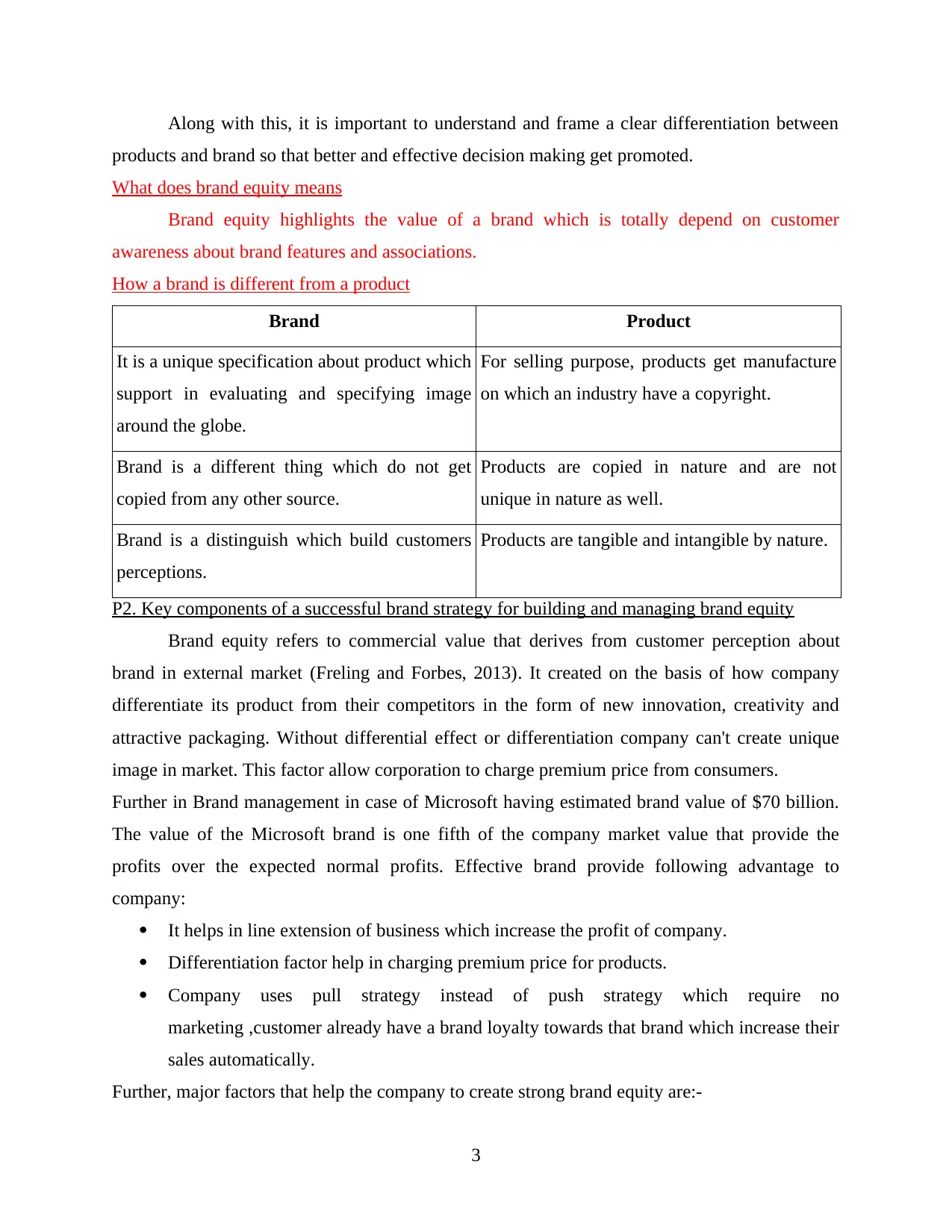
Along with this, it is important to understand and frame a clear differentiation between
products and brand so that better and effective decision making get promoted.
What does brand equity means
Brand equity highlights the value of a brand which is totally depend on customer
awareness about brand features and associations.
How a brand is different from a product
Brand Product
It is a unique specification about product which
support in evaluating and specifying image
around the globe.
For selling purpose, products get manufacture
on which an industry have a copyright.
Brand is a different thing which do not get
copied from any other source.
Products are copied in nature and are not
unique in nature as well.
Brand is a distinguish which build customers
perceptions.
Products are tangible and intangible by nature.
P2. Key components of a successful brand strategy for building and managing brand equity
Brand equity refers to commercial value that derives from customer perception about
brand in external market (Freling and Forbes, 2013). It created on the basis of how company
differentiate its product from their competitors in the form of new innovation, creativity and
attractive packaging. Without differential effect or differentiation company can't create unique
image in market. This factor allow corporation to charge premium price from consumers.
Further in Brand management in case of Microsoft having estimated brand value of $70 billion.
The value of the Microsoft brand is one fifth of the company market value that provide the
profits over the expected normal profits. Effective brand provide following advantage to
company:
It helps in line extension of business which increase the profit of company.
Differentiation factor help in charging premium price for products.
Company uses pull strategy instead of push strategy which require no
marketing ,customer already have a brand loyalty towards that brand which increase their
sales automatically.
Further, major factors that help the company to create strong brand equity are:-
3
products and brand so that better and effective decision making get promoted.
What does brand equity means
Brand equity highlights the value of a brand which is totally depend on customer
awareness about brand features and associations.
How a brand is different from a product
Brand Product
It is a unique specification about product which
support in evaluating and specifying image
around the globe.
For selling purpose, products get manufacture
on which an industry have a copyright.
Brand is a different thing which do not get
copied from any other source.
Products are copied in nature and are not
unique in nature as well.
Brand is a distinguish which build customers
perceptions.
Products are tangible and intangible by nature.
P2. Key components of a successful brand strategy for building and managing brand equity
Brand equity refers to commercial value that derives from customer perception about
brand in external market (Freling and Forbes, 2013). It created on the basis of how company
differentiate its product from their competitors in the form of new innovation, creativity and
attractive packaging. Without differential effect or differentiation company can't create unique
image in market. This factor allow corporation to charge premium price from consumers.
Further in Brand management in case of Microsoft having estimated brand value of $70 billion.
The value of the Microsoft brand is one fifth of the company market value that provide the
profits over the expected normal profits. Effective brand provide following advantage to
company:
It helps in line extension of business which increase the profit of company.
Differentiation factor help in charging premium price for products.
Company uses pull strategy instead of push strategy which require no
marketing ,customer already have a brand loyalty towards that brand which increase their
sales automatically.
Further, major factors that help the company to create strong brand equity are:-
3
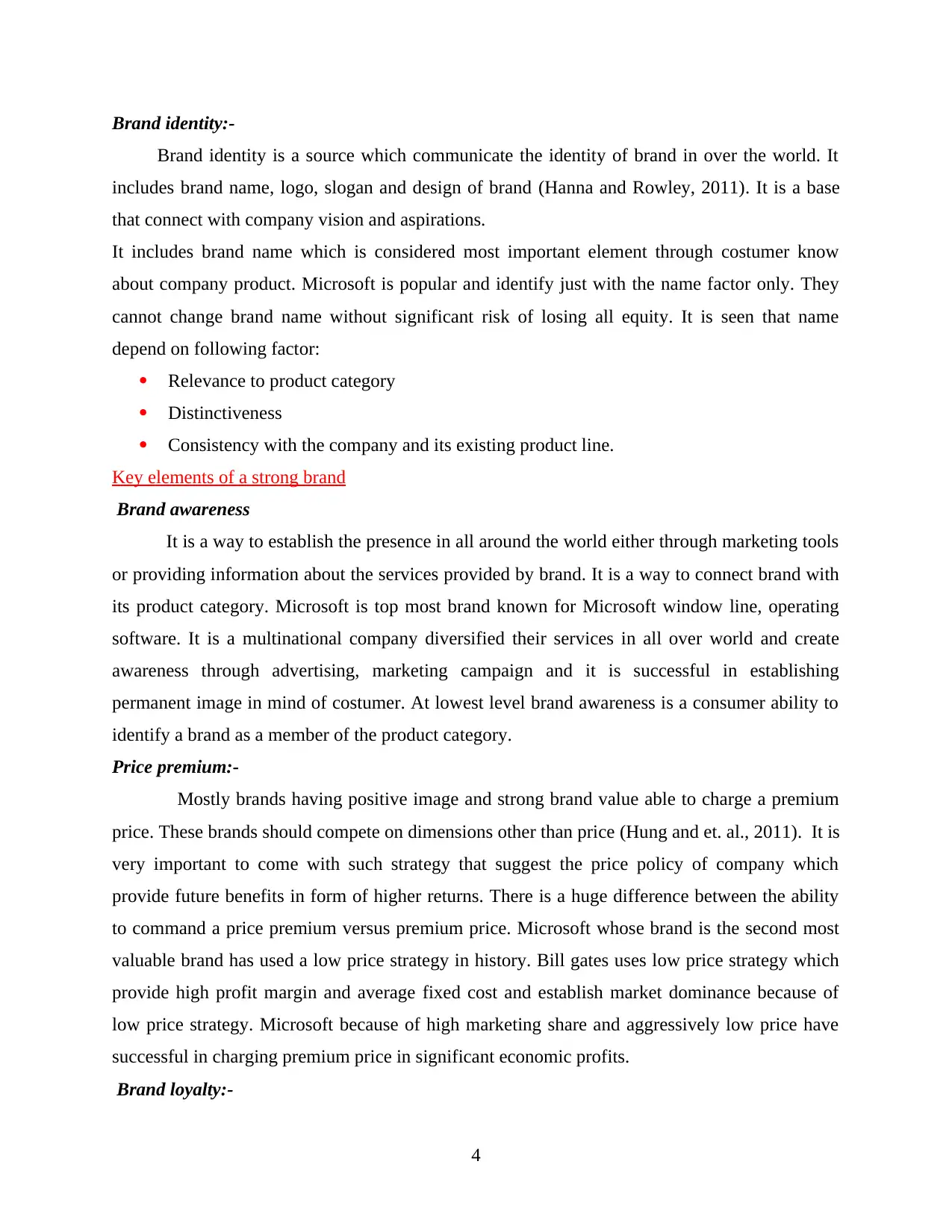
Brand identity:-
Brand identity is a source which communicate the identity of brand in over the world. It
includes brand name, logo, slogan and design of brand (Hanna and Rowley, 2011). It is a base
that connect with company vision and aspirations.
It includes brand name which is considered most important element through costumer know
about company product. Microsoft is popular and identify just with the name factor only. They
cannot change brand name without significant risk of losing all equity. It is seen that name
depend on following factor:
Relevance to product category
Distinctiveness
Consistency with the company and its existing product line.
Key elements of a strong brand
Brand awareness
It is a way to establish the presence in all around the world either through marketing tools
or providing information about the services provided by brand. It is a way to connect brand with
its product category. Microsoft is top most brand known for Microsoft window line, operating
software. It is a multinational company diversified their services in all over world and create
awareness through advertising, marketing campaign and it is successful in establishing
permanent image in mind of costumer. At lowest level brand awareness is a consumer ability to
identify a brand as a member of the product category.
Price premium:-
Mostly brands having positive image and strong brand value able to charge a premium
price. These brands should compete on dimensions other than price (Hung and et. al., 2011). It is
very important to come with such strategy that suggest the price policy of company which
provide future benefits in form of higher returns. There is a huge difference between the ability
to command a price premium versus premium price. Microsoft whose brand is the second most
valuable brand has used a low price strategy in history. Bill gates uses low price strategy which
provide high profit margin and average fixed cost and establish market dominance because of
low price strategy. Microsoft because of high marketing share and aggressively low price have
successful in charging premium price in significant economic profits.
Brand loyalty:-
4
Brand identity is a source which communicate the identity of brand in over the world. It
includes brand name, logo, slogan and design of brand (Hanna and Rowley, 2011). It is a base
that connect with company vision and aspirations.
It includes brand name which is considered most important element through costumer know
about company product. Microsoft is popular and identify just with the name factor only. They
cannot change brand name without significant risk of losing all equity. It is seen that name
depend on following factor:
Relevance to product category
Distinctiveness
Consistency with the company and its existing product line.
Key elements of a strong brand
Brand awareness
It is a way to establish the presence in all around the world either through marketing tools
or providing information about the services provided by brand. It is a way to connect brand with
its product category. Microsoft is top most brand known for Microsoft window line, operating
software. It is a multinational company diversified their services in all over world and create
awareness through advertising, marketing campaign and it is successful in establishing
permanent image in mind of costumer. At lowest level brand awareness is a consumer ability to
identify a brand as a member of the product category.
Price premium:-
Mostly brands having positive image and strong brand value able to charge a premium
price. These brands should compete on dimensions other than price (Hung and et. al., 2011). It is
very important to come with such strategy that suggest the price policy of company which
provide future benefits in form of higher returns. There is a huge difference between the ability
to command a price premium versus premium price. Microsoft whose brand is the second most
valuable brand has used a low price strategy in history. Bill gates uses low price strategy which
provide high profit margin and average fixed cost and establish market dominance because of
low price strategy. Microsoft because of high marketing share and aggressively low price have
successful in charging premium price in significant economic profits.
Brand loyalty:-
4
⊘ This is a preview!⊘
Do you want full access?
Subscribe today to unlock all pages.

Trusted by 1+ million students worldwide
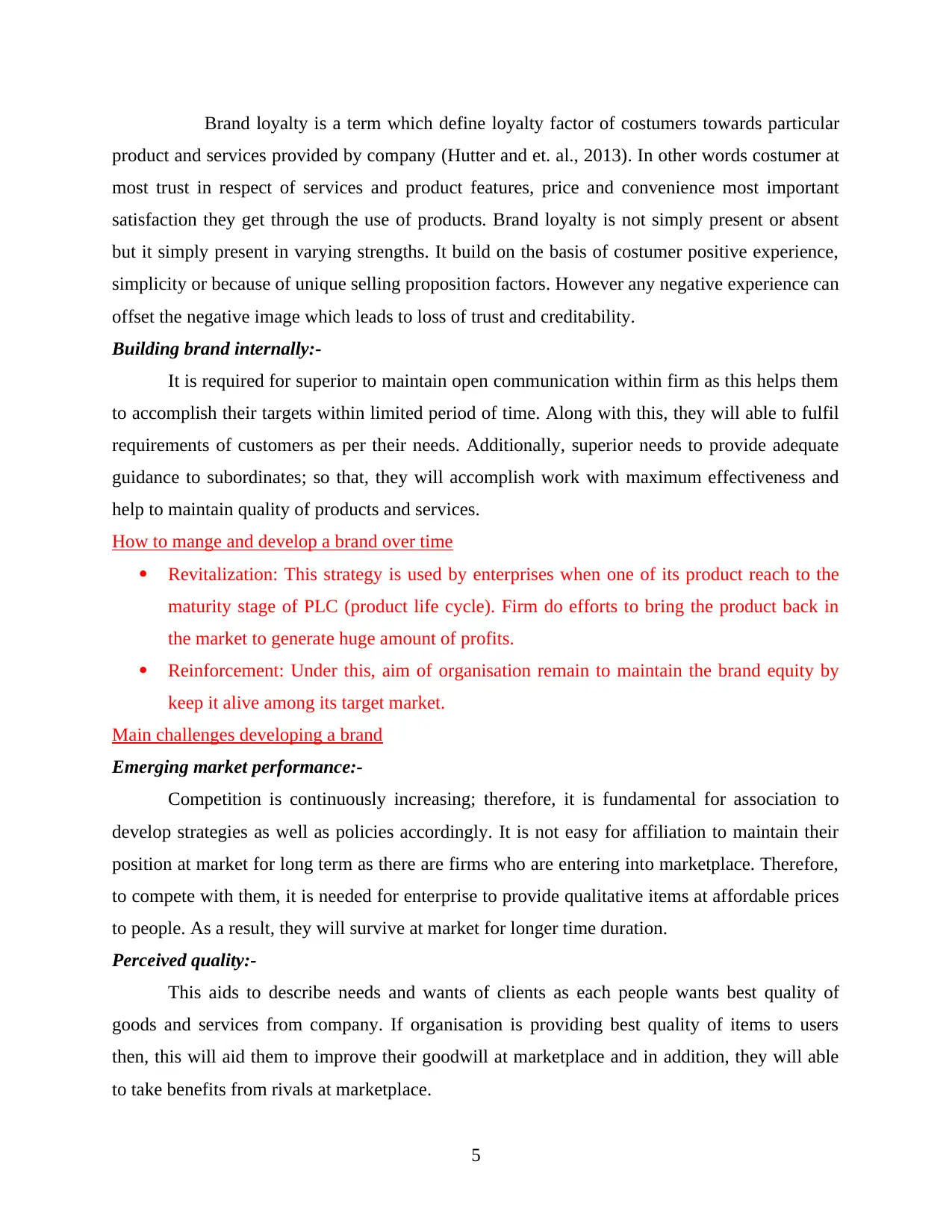
Brand loyalty is a term which define loyalty factor of costumers towards particular
product and services provided by company (Hutter and et. al., 2013). In other words costumer at
most trust in respect of services and product features, price and convenience most important
satisfaction they get through the use of products. Brand loyalty is not simply present or absent
but it simply present in varying strengths. It build on the basis of costumer positive experience,
simplicity or because of unique selling proposition factors. However any negative experience can
offset the negative image which leads to loss of trust and creditability.
Building brand internally:-
It is required for superior to maintain open communication within firm as this helps them
to accomplish their targets within limited period of time. Along with this, they will able to fulfil
requirements of customers as per their needs. Additionally, superior needs to provide adequate
guidance to subordinates; so that, they will accomplish work with maximum effectiveness and
help to maintain quality of products and services.
How to mange and develop a brand over time
Revitalization: This strategy is used by enterprises when one of its product reach to the
maturity stage of PLC (product life cycle). Firm do efforts to bring the product back in
the market to generate huge amount of profits.
Reinforcement: Under this, aim of organisation remain to maintain the brand equity by
keep it alive among its target market.
Main challenges developing a brand
Emerging market performance:-
Competition is continuously increasing; therefore, it is fundamental for association to
develop strategies as well as policies accordingly. It is not easy for affiliation to maintain their
position at market for long term as there are firms who are entering into marketplace. Therefore,
to compete with them, it is needed for enterprise to provide qualitative items at affordable prices
to people. As a result, they will survive at market for longer time duration.
Perceived quality:-
This aids to describe needs and wants of clients as each people wants best quality of
goods and services from company. If organisation is providing best quality of items to users
then, this will aid them to improve their goodwill at marketplace and in addition, they will able
to take benefits from rivals at marketplace.
5
product and services provided by company (Hutter and et. al., 2013). In other words costumer at
most trust in respect of services and product features, price and convenience most important
satisfaction they get through the use of products. Brand loyalty is not simply present or absent
but it simply present in varying strengths. It build on the basis of costumer positive experience,
simplicity or because of unique selling proposition factors. However any negative experience can
offset the negative image which leads to loss of trust and creditability.
Building brand internally:-
It is required for superior to maintain open communication within firm as this helps them
to accomplish their targets within limited period of time. Along with this, they will able to fulfil
requirements of customers as per their needs. Additionally, superior needs to provide adequate
guidance to subordinates; so that, they will accomplish work with maximum effectiveness and
help to maintain quality of products and services.
How to mange and develop a brand over time
Revitalization: This strategy is used by enterprises when one of its product reach to the
maturity stage of PLC (product life cycle). Firm do efforts to bring the product back in
the market to generate huge amount of profits.
Reinforcement: Under this, aim of organisation remain to maintain the brand equity by
keep it alive among its target market.
Main challenges developing a brand
Emerging market performance:-
Competition is continuously increasing; therefore, it is fundamental for association to
develop strategies as well as policies accordingly. It is not easy for affiliation to maintain their
position at market for long term as there are firms who are entering into marketplace. Therefore,
to compete with them, it is needed for enterprise to provide qualitative items at affordable prices
to people. As a result, they will survive at market for longer time duration.
Perceived quality:-
This aids to describe needs and wants of clients as each people wants best quality of
goods and services from company. If organisation is providing best quality of items to users
then, this will aid them to improve their goodwill at marketplace and in addition, they will able
to take benefits from rivals at marketplace.
5
Paraphrase This Document
Need a fresh take? Get an instant paraphrase of this document with our AI Paraphraser
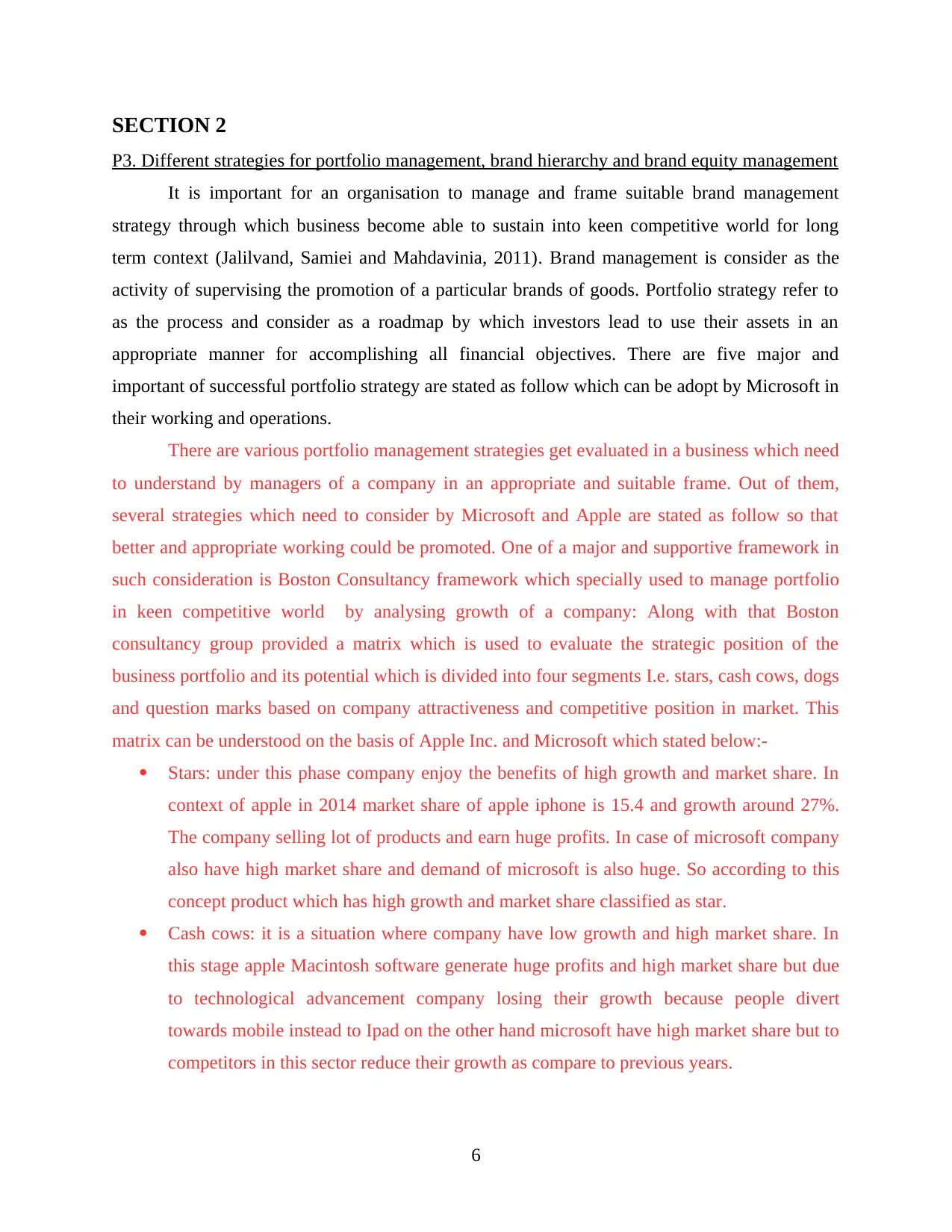
SECTION 2
P3. Different strategies for portfolio management, brand hierarchy and brand equity management
It is important for an organisation to manage and frame suitable brand management
strategy through which business become able to sustain into keen competitive world for long
term context (Jalilvand, Samiei and Mahdavinia, 2011). Brand management is consider as the
activity of supervising the promotion of a particular brands of goods. Portfolio strategy refer to
as the process and consider as a roadmap by which investors lead to use their assets in an
appropriate manner for accomplishing all financial objectives. There are five major and
important of successful portfolio strategy are stated as follow which can be adopt by Microsoft in
their working and operations.
There are various portfolio management strategies get evaluated in a business which need
to understand by managers of a company in an appropriate and suitable frame. Out of them,
several strategies which need to consider by Microsoft and Apple are stated as follow so that
better and appropriate working could be promoted. One of a major and supportive framework in
such consideration is Boston Consultancy framework which specially used to manage portfolio
in keen competitive world by analysing growth of a company: Along with that Boston
consultancy group provided a matrix which is used to evaluate the strategic position of the
business portfolio and its potential which is divided into four segments I.e. stars, cash cows, dogs
and question marks based on company attractiveness and competitive position in market. This
matrix can be understood on the basis of Apple Inc. and Microsoft which stated below:-
Stars: under this phase company enjoy the benefits of high growth and market share. In
context of apple in 2014 market share of apple iphone is 15.4 and growth around 27%.
The company selling lot of products and earn huge profits. In case of microsoft company
also have high market share and demand of microsoft is also huge. So according to this
concept product which has high growth and market share classified as star.
Cash cows: it is a situation where company have low growth and high market share. In
this stage apple Macintosh software generate huge profits and high market share but due
to technological advancement company losing their growth because people divert
towards mobile instead to Ipad on the other hand microsoft have high market share but to
competitors in this sector reduce their growth as compare to previous years.
6
P3. Different strategies for portfolio management, brand hierarchy and brand equity management
It is important for an organisation to manage and frame suitable brand management
strategy through which business become able to sustain into keen competitive world for long
term context (Jalilvand, Samiei and Mahdavinia, 2011). Brand management is consider as the
activity of supervising the promotion of a particular brands of goods. Portfolio strategy refer to
as the process and consider as a roadmap by which investors lead to use their assets in an
appropriate manner for accomplishing all financial objectives. There are five major and
important of successful portfolio strategy are stated as follow which can be adopt by Microsoft in
their working and operations.
There are various portfolio management strategies get evaluated in a business which need
to understand by managers of a company in an appropriate and suitable frame. Out of them,
several strategies which need to consider by Microsoft and Apple are stated as follow so that
better and appropriate working could be promoted. One of a major and supportive framework in
such consideration is Boston Consultancy framework which specially used to manage portfolio
in keen competitive world by analysing growth of a company: Along with that Boston
consultancy group provided a matrix which is used to evaluate the strategic position of the
business portfolio and its potential which is divided into four segments I.e. stars, cash cows, dogs
and question marks based on company attractiveness and competitive position in market. This
matrix can be understood on the basis of Apple Inc. and Microsoft which stated below:-
Stars: under this phase company enjoy the benefits of high growth and market share. In
context of apple in 2014 market share of apple iphone is 15.4 and growth around 27%.
The company selling lot of products and earn huge profits. In case of microsoft company
also have high market share and demand of microsoft is also huge. So according to this
concept product which has high growth and market share classified as star.
Cash cows: it is a situation where company have low growth and high market share. In
this stage apple Macintosh software generate huge profits and high market share but due
to technological advancement company losing their growth because people divert
towards mobile instead to Ipad on the other hand microsoft have high market share but to
competitors in this sector reduce their growth as compare to previous years.
6
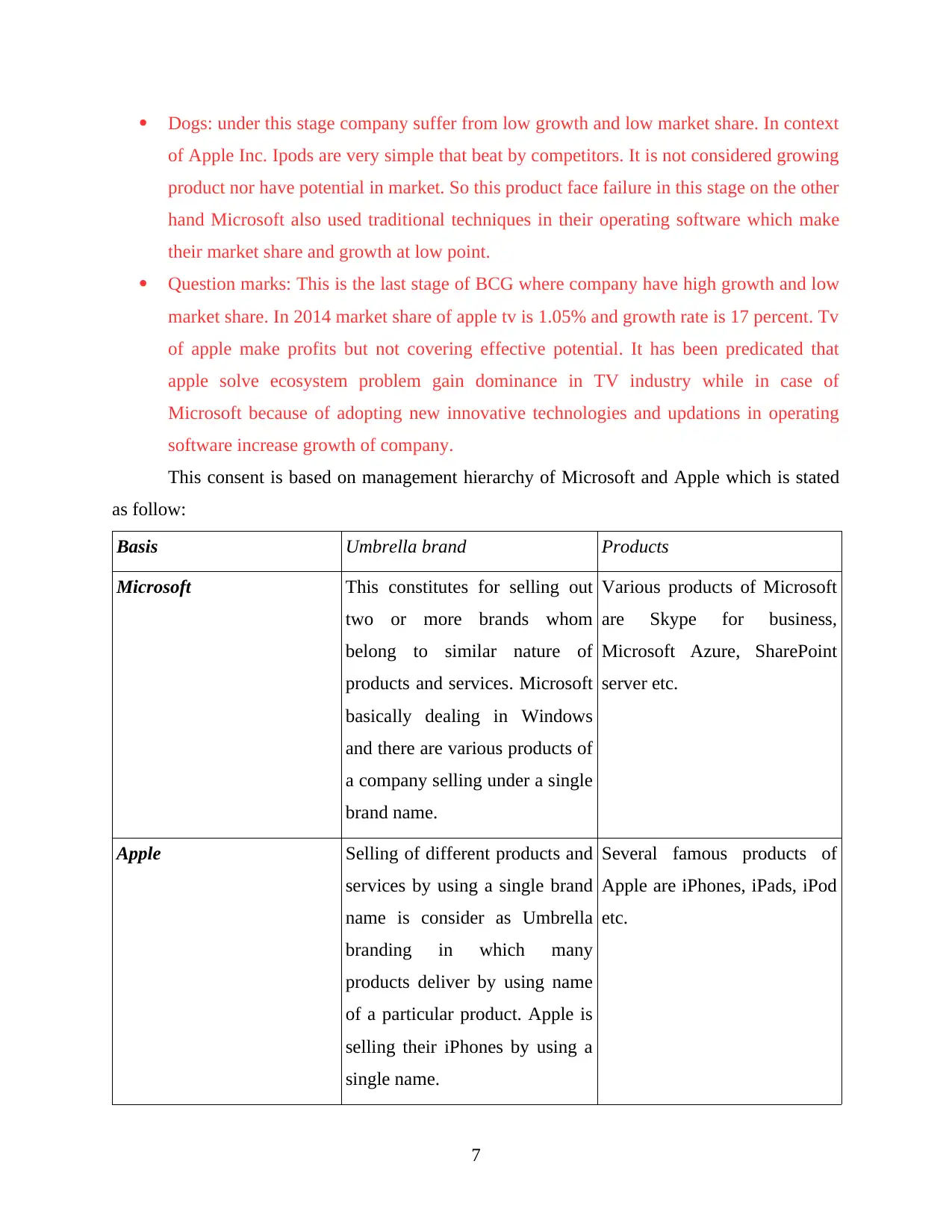
Dogs: under this stage company suffer from low growth and low market share. In context
of Apple Inc. Ipods are very simple that beat by competitors. It is not considered growing
product nor have potential in market. So this product face failure in this stage on the other
hand Microsoft also used traditional techniques in their operating software which make
their market share and growth at low point.
Question marks: This is the last stage of BCG where company have high growth and low
market share. In 2014 market share of apple tv is 1.05% and growth rate is 17 percent. Tv
of apple make profits but not covering effective potential. It has been predicated that
apple solve ecosystem problem gain dominance in TV industry while in case of
Microsoft because of adopting new innovative technologies and updations in operating
software increase growth of company.
This consent is based on management hierarchy of Microsoft and Apple which is stated
as follow:
Basis Umbrella brand Products
Microsoft This constitutes for selling out
two or more brands whom
belong to similar nature of
products and services. Microsoft
basically dealing in Windows
and there are various products of
a company selling under a single
brand name.
Various products of Microsoft
are Skype for business,
Microsoft Azure, SharePoint
server etc.
Apple Selling of different products and
services by using a single brand
name is consider as Umbrella
branding in which many
products deliver by using name
of a particular product. Apple is
selling their iPhones by using a
single name.
Several famous products of
Apple are iPhones, iPads, iPod
etc.
7
of Apple Inc. Ipods are very simple that beat by competitors. It is not considered growing
product nor have potential in market. So this product face failure in this stage on the other
hand Microsoft also used traditional techniques in their operating software which make
their market share and growth at low point.
Question marks: This is the last stage of BCG where company have high growth and low
market share. In 2014 market share of apple tv is 1.05% and growth rate is 17 percent. Tv
of apple make profits but not covering effective potential. It has been predicated that
apple solve ecosystem problem gain dominance in TV industry while in case of
Microsoft because of adopting new innovative technologies and updations in operating
software increase growth of company.
This consent is based on management hierarchy of Microsoft and Apple which is stated
as follow:
Basis Umbrella brand Products
Microsoft This constitutes for selling out
two or more brands whom
belong to similar nature of
products and services. Microsoft
basically dealing in Windows
and there are various products of
a company selling under a single
brand name.
Various products of Microsoft
are Skype for business,
Microsoft Azure, SharePoint
server etc.
Apple Selling of different products and
services by using a single brand
name is consider as Umbrella
branding in which many
products deliver by using name
of a particular product. Apple is
selling their iPhones by using a
single name.
Several famous products of
Apple are iPhones, iPads, iPod
etc.
7
⊘ This is a preview!⊘
Do you want full access?
Subscribe today to unlock all pages.

Trusted by 1+ million students worldwide
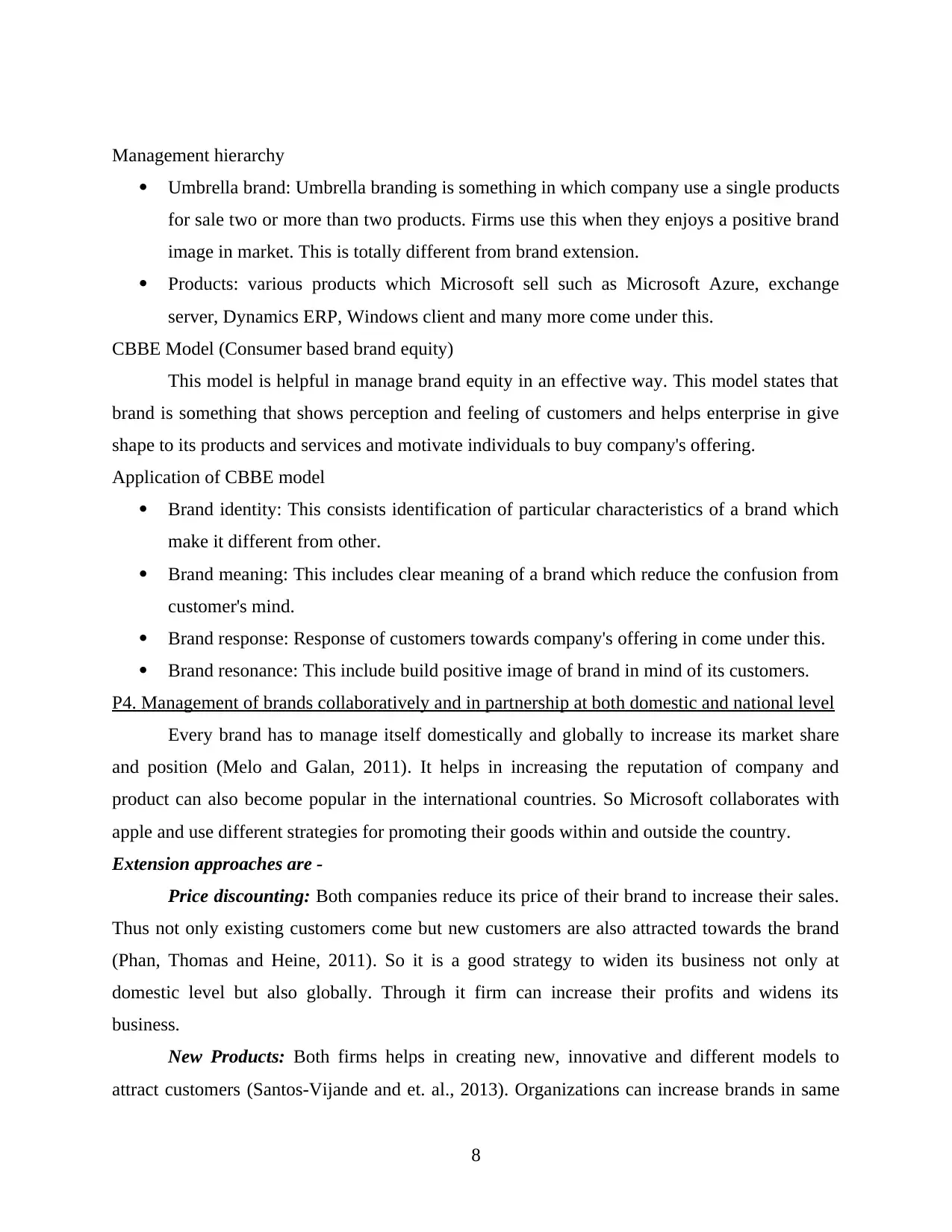
Management hierarchy
Umbrella brand: Umbrella branding is something in which company use a single products
for sale two or more than two products. Firms use this when they enjoys a positive brand
image in market. This is totally different from brand extension.
Products: various products which Microsoft sell such as Microsoft Azure, exchange
server, Dynamics ERP, Windows client and many more come under this.
CBBE Model (Consumer based brand equity)
This model is helpful in manage brand equity in an effective way. This model states that
brand is something that shows perception and feeling of customers and helps enterprise in give
shape to its products and services and motivate individuals to buy company's offering.
Application of CBBE model
Brand identity: This consists identification of particular characteristics of a brand which
make it different from other.
Brand meaning: This includes clear meaning of a brand which reduce the confusion from
customer's mind.
Brand response: Response of customers towards company's offering in come under this.
Brand resonance: This include build positive image of brand in mind of its customers.
P4. Management of brands collaboratively and in partnership at both domestic and national level
Every brand has to manage itself domestically and globally to increase its market share
and position (Melo and Galan, 2011). It helps in increasing the reputation of company and
product can also become popular in the international countries. So Microsoft collaborates with
apple and use different strategies for promoting their goods within and outside the country.
Extension approaches are -
Price discounting: Both companies reduce its price of their brand to increase their sales.
Thus not only existing customers come but new customers are also attracted towards the brand
(Phan, Thomas and Heine, 2011). So it is a good strategy to widen its business not only at
domestic level but also globally. Through it firm can increase their profits and widens its
business.
New Products: Both firms helps in creating new, innovative and different models to
attract customers (Santos-Vijande and et. al., 2013). Organizations can increase brands in same
8
Umbrella brand: Umbrella branding is something in which company use a single products
for sale two or more than two products. Firms use this when they enjoys a positive brand
image in market. This is totally different from brand extension.
Products: various products which Microsoft sell such as Microsoft Azure, exchange
server, Dynamics ERP, Windows client and many more come under this.
CBBE Model (Consumer based brand equity)
This model is helpful in manage brand equity in an effective way. This model states that
brand is something that shows perception and feeling of customers and helps enterprise in give
shape to its products and services and motivate individuals to buy company's offering.
Application of CBBE model
Brand identity: This consists identification of particular characteristics of a brand which
make it different from other.
Brand meaning: This includes clear meaning of a brand which reduce the confusion from
customer's mind.
Brand response: Response of customers towards company's offering in come under this.
Brand resonance: This include build positive image of brand in mind of its customers.
P4. Management of brands collaboratively and in partnership at both domestic and national level
Every brand has to manage itself domestically and globally to increase its market share
and position (Melo and Galan, 2011). It helps in increasing the reputation of company and
product can also become popular in the international countries. So Microsoft collaborates with
apple and use different strategies for promoting their goods within and outside the country.
Extension approaches are -
Price discounting: Both companies reduce its price of their brand to increase their sales.
Thus not only existing customers come but new customers are also attracted towards the brand
(Phan, Thomas and Heine, 2011). So it is a good strategy to widen its business not only at
domestic level but also globally. Through it firm can increase their profits and widens its
business.
New Products: Both firms helps in creating new, innovative and different models to
attract customers (Santos-Vijande and et. al., 2013). Organizations can increase brands in same
8
Paraphrase This Document
Need a fresh take? Get an instant paraphrase of this document with our AI Paraphraser
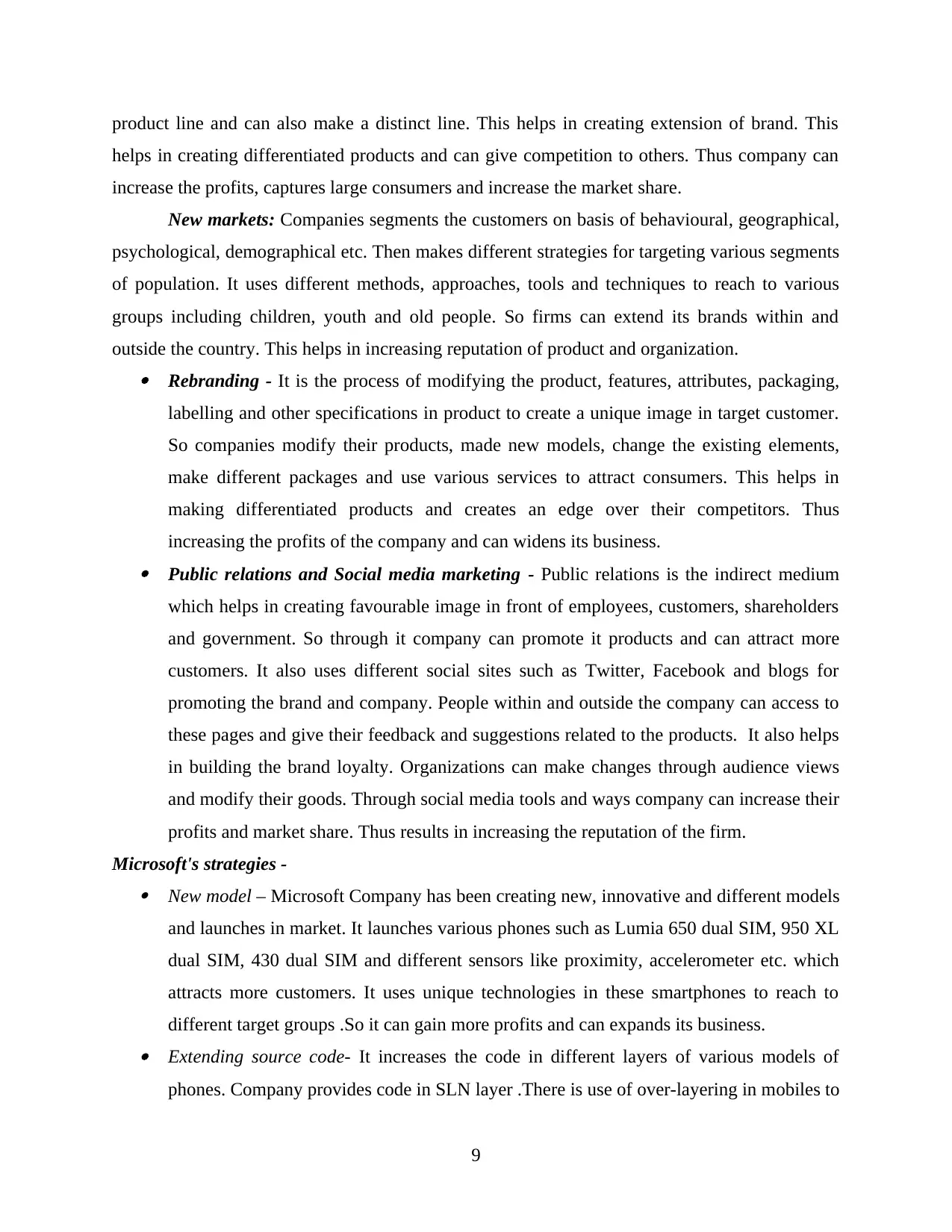
product line and can also make a distinct line. This helps in creating extension of brand. This
helps in creating differentiated products and can give competition to others. Thus company can
increase the profits, captures large consumers and increase the market share.
New markets: Companies segments the customers on basis of behavioural, geographical,
psychological, demographical etc. Then makes different strategies for targeting various segments
of population. It uses different methods, approaches, tools and techniques to reach to various
groups including children, youth and old people. So firms can extend its brands within and
outside the country. This helps in increasing reputation of product and organization. Rebranding - It is the process of modifying the product, features, attributes, packaging,
labelling and other specifications in product to create a unique image in target customer.
So companies modify their products, made new models, change the existing elements,
make different packages and use various services to attract consumers. This helps in
making differentiated products and creates an edge over their competitors. Thus
increasing the profits of the company and can widens its business. Public relations and Social media marketing - Public relations is the indirect medium
which helps in creating favourable image in front of employees, customers, shareholders
and government. So through it company can promote it products and can attract more
customers. It also uses different social sites such as Twitter, Facebook and blogs for
promoting the brand and company. People within and outside the company can access to
these pages and give their feedback and suggestions related to the products. It also helps
in building the brand loyalty. Organizations can make changes through audience views
and modify their goods. Through social media tools and ways company can increase their
profits and market share. Thus results in increasing the reputation of the firm.
Microsoft's strategies - New model – Microsoft Company has been creating new, innovative and different models
and launches in market. It launches various phones such as Lumia 650 dual SIM, 950 XL
dual SIM, 430 dual SIM and different sensors like proximity, accelerometer etc. which
attracts more customers. It uses unique technologies in these smartphones to reach to
different target groups .So it can gain more profits and can expands its business. Extending source code- It increases the code in different layers of various models of
phones. Company provides code in SLN layer .There is use of over-layering in mobiles to
9
helps in creating differentiated products and can give competition to others. Thus company can
increase the profits, captures large consumers and increase the market share.
New markets: Companies segments the customers on basis of behavioural, geographical,
psychological, demographical etc. Then makes different strategies for targeting various segments
of population. It uses different methods, approaches, tools and techniques to reach to various
groups including children, youth and old people. So firms can extend its brands within and
outside the country. This helps in increasing reputation of product and organization. Rebranding - It is the process of modifying the product, features, attributes, packaging,
labelling and other specifications in product to create a unique image in target customer.
So companies modify their products, made new models, change the existing elements,
make different packages and use various services to attract consumers. This helps in
making differentiated products and creates an edge over their competitors. Thus
increasing the profits of the company and can widens its business. Public relations and Social media marketing - Public relations is the indirect medium
which helps in creating favourable image in front of employees, customers, shareholders
and government. So through it company can promote it products and can attract more
customers. It also uses different social sites such as Twitter, Facebook and blogs for
promoting the brand and company. People within and outside the company can access to
these pages and give their feedback and suggestions related to the products. It also helps
in building the brand loyalty. Organizations can make changes through audience views
and modify their goods. Through social media tools and ways company can increase their
profits and market share. Thus results in increasing the reputation of the firm.
Microsoft's strategies - New model – Microsoft Company has been creating new, innovative and different models
and launches in market. It launches various phones such as Lumia 650 dual SIM, 950 XL
dual SIM, 430 dual SIM and different sensors like proximity, accelerometer etc. which
attracts more customers. It uses unique technologies in these smartphones to reach to
different target groups .So it can gain more profits and can expands its business. Extending source code- It increases the code in different layers of various models of
phones. Company provides code in SLN layer .There is use of over-layering in mobiles to
9
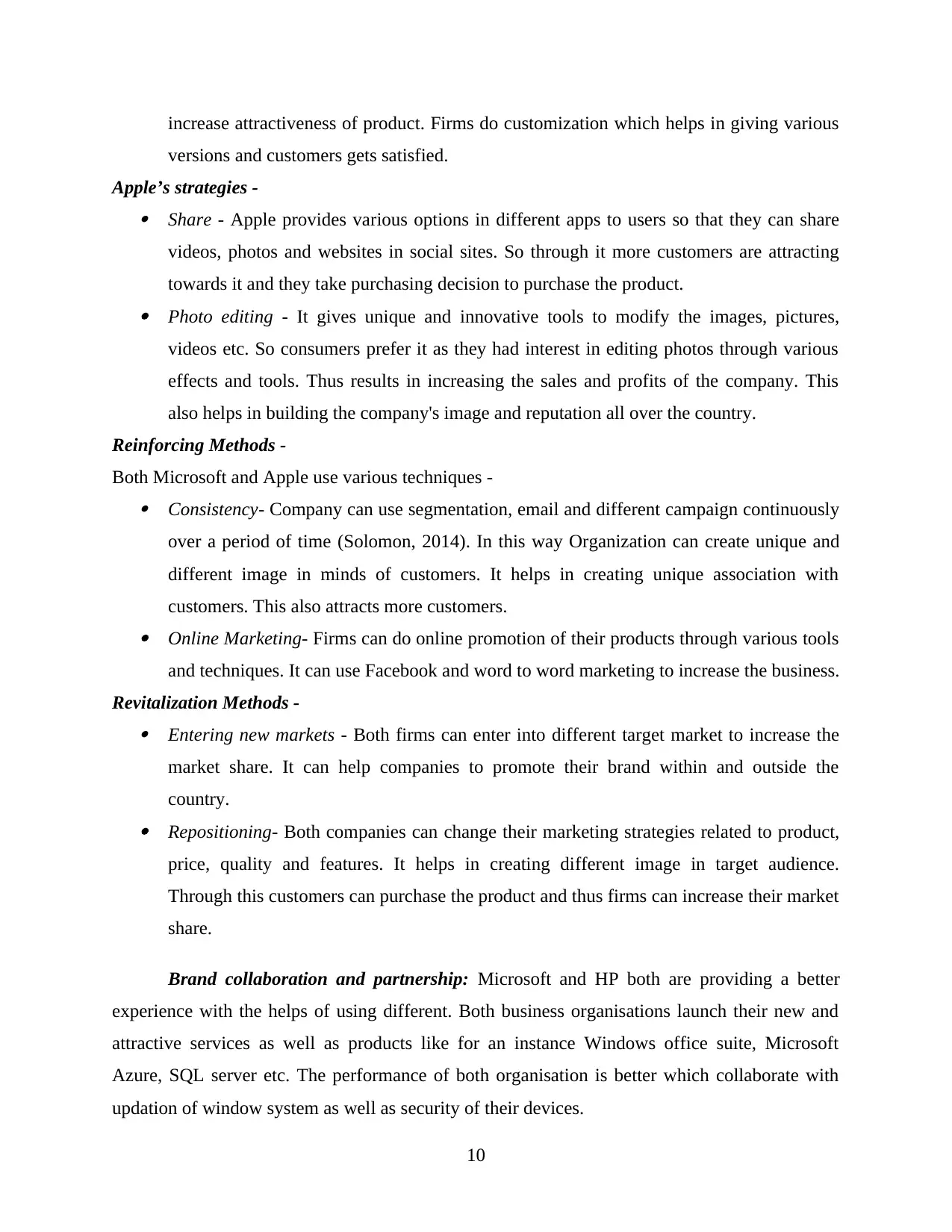
increase attractiveness of product. Firms do customization which helps in giving various
versions and customers gets satisfied.
Apple’s strategies - Share - Apple provides various options in different apps to users so that they can share
videos, photos and websites in social sites. So through it more customers are attracting
towards it and they take purchasing decision to purchase the product. Photo editing - It gives unique and innovative tools to modify the images, pictures,
videos etc. So consumers prefer it as they had interest in editing photos through various
effects and tools. Thus results in increasing the sales and profits of the company. This
also helps in building the company's image and reputation all over the country.
Reinforcing Methods -
Both Microsoft and Apple use various techniques - Consistency- Company can use segmentation, email and different campaign continuously
over a period of time (Solomon, 2014). In this way Organization can create unique and
different image in minds of customers. It helps in creating unique association with
customers. This also attracts more customers. Online Marketing- Firms can do online promotion of their products through various tools
and techniques. It can use Facebook and word to word marketing to increase the business.
Revitalization Methods - Entering new markets - Both firms can enter into different target market to increase the
market share. It can help companies to promote their brand within and outside the
country. Repositioning- Both companies can change their marketing strategies related to product,
price, quality and features. It helps in creating different image in target audience.
Through this customers can purchase the product and thus firms can increase their market
share.
Brand collaboration and partnership: Microsoft and HP both are providing a better
experience with the helps of using different. Both business organisations launch their new and
attractive services as well as products like for an instance Windows office suite, Microsoft
Azure, SQL server etc. The performance of both organisation is better which collaborate with
updation of window system as well as security of their devices.
10
versions and customers gets satisfied.
Apple’s strategies - Share - Apple provides various options in different apps to users so that they can share
videos, photos and websites in social sites. So through it more customers are attracting
towards it and they take purchasing decision to purchase the product. Photo editing - It gives unique and innovative tools to modify the images, pictures,
videos etc. So consumers prefer it as they had interest in editing photos through various
effects and tools. Thus results in increasing the sales and profits of the company. This
also helps in building the company's image and reputation all over the country.
Reinforcing Methods -
Both Microsoft and Apple use various techniques - Consistency- Company can use segmentation, email and different campaign continuously
over a period of time (Solomon, 2014). In this way Organization can create unique and
different image in minds of customers. It helps in creating unique association with
customers. This also attracts more customers. Online Marketing- Firms can do online promotion of their products through various tools
and techniques. It can use Facebook and word to word marketing to increase the business.
Revitalization Methods - Entering new markets - Both firms can enter into different target market to increase the
market share. It can help companies to promote their brand within and outside the
country. Repositioning- Both companies can change their marketing strategies related to product,
price, quality and features. It helps in creating different image in target audience.
Through this customers can purchase the product and thus firms can increase their market
share.
Brand collaboration and partnership: Microsoft and HP both are providing a better
experience with the helps of using different. Both business organisations launch their new and
attractive services as well as products like for an instance Windows office suite, Microsoft
Azure, SQL server etc. The performance of both organisation is better which collaborate with
updation of window system as well as security of their devices.
10
⊘ This is a preview!⊘
Do you want full access?
Subscribe today to unlock all pages.

Trusted by 1+ million students worldwide
1 out of 17
Related Documents
Your All-in-One AI-Powered Toolkit for Academic Success.
+13062052269
info@desklib.com
Available 24*7 on WhatsApp / Email
![[object Object]](/_next/static/media/star-bottom.7253800d.svg)
Unlock your academic potential
Copyright © 2020–2025 A2Z Services. All Rights Reserved. Developed and managed by ZUCOL.





